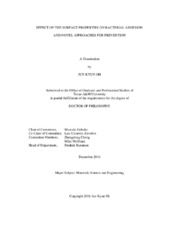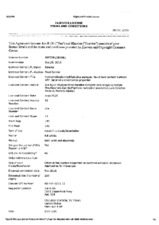| dc.description.abstract | The aim of this research was to investigate the potential of silica-based surface modification methods to prevent bacterial attachment to material surfaces. This dissertation presents the sol-gel method, reactive-ion etching (RIE) method, and dip-coating method to fabricate bacteria repelling hygienic materials.
The bacterial antiadhesion properties of hydrophobically-modified silica aerogels, with other distinctive characteristics including superior thermal insulation and ultra-light weight, make these aerogels attractive candidates for novel food-contact surfaces to improve food safety. Moreover, healthcare-associated infections (HAIs) caused by pathogenic bacteria are a worldwide problem and are responsible for numerous cases of morbidity and mortality. Findings from the study also showed that hydrophobic nanoporous silica aerogel (HNSA) has potential as an antiadhesive hygienic material that can inhibit exogenous bacterial contamination. The results suggest that the use of HNSA as surfaces that come into contact with bacterial pathogens in the healthcare environment can improve bacterial hygiene, and therefore, may reduce the rate of HAIs.
Because of the growing prevalence of antimicrobial-resistant strains, there is an increasing need to develop material surfaces that prevent bacteria in the absence of antibiotic agents. Herein, we present a self-masking reactive-ion etching (SM-RIE) approach for bacterial antiadhesive "rice leaf-like surfaces" (RLLS). RLLS surfaces showed exceptional bacterial antiadhesion properties with a >99.9% adhesion inhibition efficiency, as well as demonstrated optical-grade transparency (i.e., ≥92% transmission). We anticipate that the combination of bacterial antiadhesion efficiency, optical-grade transparency, and convenient single-step method of preparation makes RLLS a very attractive candidate surface for biosensors, endoscopes, microfluidic and bio-optical instruments, lab-on-a-chip, and touchscreen devices.
Gloves made of materials such as latex, nitrile, and polyethylene are the most common types of protective equipment used to prevent cross-contamination and transmission of pathogenic bacteria in the food industry. In this study, we report a surface modification by dip-coating method involving "fluorinated silica nanoparticles" (FSNs) to improve the protective ability against bacterial contamination of disposable glove surfaces. The bacterial populations on FSN-coated latex, nitrile and polyethylene gloves was reduced by 1–2 log units in comparison to bare gloves, which already reduce the bacterial attachment to some extent. | en |



